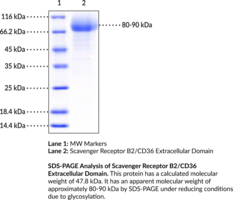Territorial Availability: Available through Bertin Technologies only in France
- Correlated keywords
- HEK-293 CD-36 TSP1 STAT-3 HIF1? HIF1-? Plasmodium SCARB3 SR-B2 SRB2 FAT Glycoprotein IIIB PAS-4 PAS4 SCARB-3
- Product Overview:
CD36, also known as scavenger receptor B2 or fatty acid translocase, is a transmembrane glycoprotein that has roles in fatty acid uptake and lipid metabolism and signaling.{62494} It is composed of N- and C-terminal cytoplasmic tails, two transmembrane domains, and an extracellular loop that binds to a variety of lipid ligands, including long-chain fatty acids, oxidized LDL, and oxidized phospholipids, and protein ligands, such as thrombospondin (TSP-1), and is subject to post-translational modifications.{62494,62495,62496} CD36 is expressed by a variety of cells, including hematopoietic cells such as platelets, monocytes, and macrophages, as well as adipocytes, enterocytes, cardiac and skeletal myocytes, and endothelial and epithelial cells.{62494,62497} It also exists as a soluble form, sCD36, which is produced via plasma proteases.{62495} CD36 expression is regulated by several transcription factors, including peroxisome proliferator-activated receptor (PPAR), STAT3, and hypoxia-inducible factor-1? (HIF-1?), in a tissue-dependent manner.{62496,62494} It is localized to the plasma membrane and within endosomes, the endoplasmic reticulum, and mitochondria, and is translocated between these compartments in response to various stimuli, including insulin-induced PI3K signaling and muscle contraction-induced AMPK signaling, to regulate fatty acid uptake.{62495,62496} It has additional roles in the phagocytosis of apoptotic cells and P. falciparum-infected red blood cells (RBCs), angiogenesis, thrombosis, inflammation, and atherosclerosis, as well as cancer metastasis.{62498,62496} Cayman’s Scavenger Receptor B2/CD36 Extracellular Domain (mouse, recombinant) protein can be used for binding assays. This protein consists of 421 amino acids and has a calculated molecular weight of 47.8 kDa. By SDS-PAGE, under reducing conditions, the apparent molecular mass of the protein is 80-90 kDa due to glycosylation.
Cayman Chemical’s mission is to help make research possible by supplying scientists worldwide with the basic research tools necessary for advancing human and animal health. Our utmost commitment to healthcare researchers is to offer the highest quality products with an affordable pricing policy.
Our scientists are experts in the synthesis, purification, and characterization of biochemicals ranging from small drug-like heterocycles to complex biolipids, fatty acids, and many others. We are also highly skilled in all aspects of assay and antibody development, protein expression, crystallization, and structure determination.
Over the past thirty years, Cayman developed a deep knowledge base in lipid biochemistry, including research involving the arachidonic acid cascade, inositol phosphates, and cannabinoids. This knowledge enabled the production of reagents of exceptional quality for cancer, oxidative injury, epigenetics, neuroscience, inflammation, metabolism, and many additional lines of research.
Our organic and analytical chemists specialize in the rapid development of manufacturing processes and analytical methods to carry out clinical and commercial GMP-API production. Pre-clinical drug discovery efforts are currently underway in the areas of bone restoration and repair, muscular dystrophy, oncology, and inflammation. A separate group of Ph.D.-level scientists are dedicated to offering Hit-to-Lead Discovery and Profiling Services for epigenetic targets. Our knowledgeable chemists can be contracted to perform complete sample analysis for analytes measured by the majority of our assays. We also offer a wide range of analytical services using LC-MS/MS, HPLC, GC, and many other techniques.
Accreditations
ISO/IEC 17025:2005
ISO Guide 34:2009
Cayman is a leader in the field of emerging drugs of abuse, providing high-purity Schedule I-V Controlled Substances to federally-licensed laboratories and qualified academic research institutions for forensic analyses. We are certified by ACLASS Accreditation Services with dual accreditation to ISO/IEC 17025:2005 and ISO Guide 34:2009.





